By Jeffrey A. Rendall, Photos By Kevin Gaydosh
(Ed Note: This story was written in June of 2003 -- it tells the tale of the historic Pinehurst #2, and provides some insight into what the pros will face during the US Open in 2005. For an update on the course after the Crenshaw and Coore restoration, click here.)
PINEHURST, NC -- "It exceeded every expectation," replied Pinehurst Resort's Director of Golf, Matt Massei, when asked how he'd like folks to remember the experience after finishing a round on the legendary Course 2. The Donald Ross designed masterpiece originally opened in 1907, but was constantly tinkered with by the old Scottish master until his death in 1948, and was subsequently restored to its historic proportions by the 'Open Doctor,' Rees Jones, in the mid-nineties.
So much has been said and written about the course, which permanently resides in most publications' listings of top golf courses in not only the United States, but the world -- that it's difficult to separate fact from hyperbole. Course 2 has hosted numerous championships of virtually all types, including the 1999 United States Open, where Payne Stewart drained that clutch 20 foot putt on the 72nd hole to seal a one-stroke victory over expectant father Phil Mickelson (on Father's Day, no less).
The course also hosted the 2005 and 2014 US Opens, as well as the 2014 Women's US Open a week after the men's. That's quite a resume.
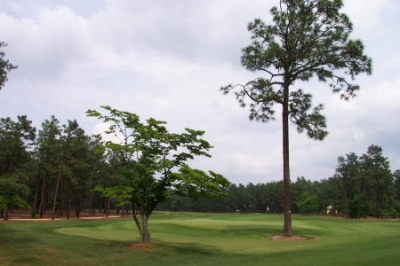 |
| From behind the 7th green, you'll get a good idea of what Pinehurst No. 2 is all about -- open spaces, pine trees, and crowned green complexes. |
Many have said the '99 event was the best US Open ever. There've been over a hundred such national championships, and admittedly I haven't witnessed the lion's share, but it was the best one I've ever seen. The fact that Stewart tragically died in a plane crash four months later only added to the legend -- the competition could very easily have stood on its own. A large part of the special nature of that tournament was due to its venue at Pinehurst, the 'Home of Golf.'
Aside from Course 2's obvious traditional and historic value, you may wonder what it is about the layout that heaps such incredible 'expectations' from players in the first place. Though Pinehurst Resort (and the greater Pinehurst area) boasts a wealth of excellent golf courses, highly rated in their own right, most people who come here have Course 2 on the brain. Like Muslims to Mecca, Christians to Bethlehem and Jews to Jerusalem, Pinehurst's Course 2 is as close to a 'shrine' as you'll find for the game of golf -- perhaps behind only Scotland's St. Andrews or Georgia's Augusta National in terms of golf's sacred ground. It's no exaggeration that playing the course is a 'religious' experience for those making the pilgrimage.
But for those who gauge the merit of golf courses by stunning aesthetic beauty and man-inspired waves of lush green fairways, gobs of colorful flowers and majestic glades, they'll be sadly disappointed. I once spoke with someone who'd recently returned from Pinehurst, and was proud to suggest that I should 'skip' playing Course 2 in favor of trying other area courses, because it was too expensive, and besides, 'except for the greens, there really isn't anything unique about it.'
Heresy, and I won't reveal the identity of the advice giver.
Although I won't grant myself the title of 'All-knower of golf course design mastery,' I will say that Course 2 exceeded my expectations -- and it was more than just the greens. It was the totality of the experience.
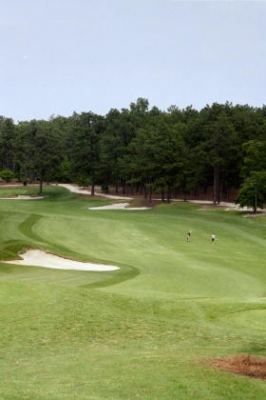 |
| The par five 4th hole provides one of Course 2's best birdie chances. Take advantage of it. |
I wouldn't say it's beautiful, however. In fact, it could very well be the gray mare flanked by a dozen chestnut stallions in the country's stable of greatest courses. There aren't any carries over the ocean, plunging rock cliffs, budding azaleas or towering oak trees. There's only one water hazard, and it really doesn't come into play. And although there's a bit of terrain variation on certain sections of the course, the rest of the layout is probably flatter than your neighborhood muni.
So what's so great about it? How will it exceed your expectations?
We'll let Massei have a try at explaining it: "People ask me all the time what makes Course 2 unique, and I'd say it's the championship tradition -- it's history. Course 2 has hosted a Ryder Cup, a PGA Championship, a US Open, a US Amateur and a US Women's Amateur (amongst others). It's one of only a few courses in that category, and that's special in itself."
Massei continues, "But I think, one of the truest tests of its mettle -- is the examination of golf it represents. When you stand on the tee and look at it, and then walk the golf course, it's like a walk in the park -- it doesn't look like it's that difficult a golf course. There're no bells & whistles, there're very few potential penalty stroke situations out there -- it's there for you to try and make a score. But it might be the hardest test of golf there is without those boundary type hazards."
"It's not demanding off the tee, and the majority of the time, the rough isn't that troubling. You can basically hit it tree line to tree line, and still advance the ball forward on your next shot," Massei said. "But once you've reached the point where you're looking to reach the green, you've got some golf to play."
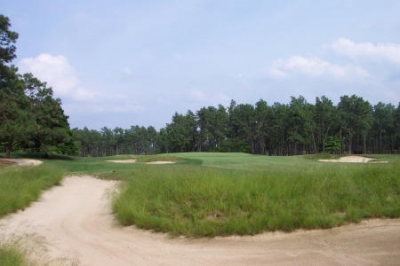 |
| Never one to hide the hazards, Donald Ross strongly suggests you stay out of his waste areas and sand bunkers. Here, it's the par four 14th hole. |
Yes indeed. Seeing the course on TV, you really can't garner the severity of the greens. They've been called domed, crowned, turtle shelled, etc... and probably any number of other things over the years. John Daly practically went nuclear on the 8th green during the '99 Open, because his ball kept rolling back down the slope to his feet -- until he finally got so frustrated he hit it while it was still moving.
In fairness to the modern pros, and just about everyone else who's fallen victim to those crowned monsters -- Ross designed them to play slightly different than they do today. Back in Ross's time, they built sand greens to play on -- which would temper the difficulties experienced with contemporary G2 bentgrass cut short, and the perfect spherical properties of the space age golf ball everyone now employs.
But despite the greens' severe looks, they play very fair. If you hit a good shot, they'll hold. If you don't, you're going to have to hit a good one on the next try to salvage a score. Ross believed the true grit of a player was measured by his ability to execute all types of shots, and that philosophy is tested at practically every turn on Pinehurst's Course 2 -- perhaps with the exception of a few tee shots.
Massei says he remembers Tom Fazio (when speaking at the opening ceremonies for Course 8) saying that Course 2 was arguably the best second shot golf course in the world. "It all starts there. You can place the ball in the middle of the fairway, 150-200 yards away from each green, and then it's good luck to try and make or beat par," Massei added.
Par's protected by the sloped greens, but also Ross's masterful placement of the bunkering. It's well known that he worked and reworked the bunkers until his death, and at first glance, some of them might not look like they're in play -- sitting 20 to 30 yards before a green, or in a fairway spot that appears to be out of the way. But everything's there for a reason, as attested to by people who've played the course many times.
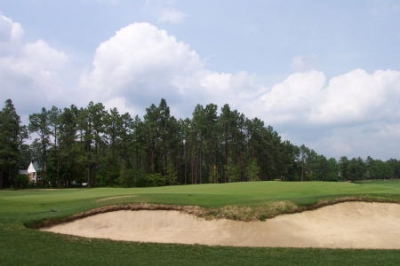 |
| Ross's house was located near the 3rd green, which certainly gave him time to make it just the way he wanted it. |
Rees Jones could tell you, having reworked the course in 1996 to conform to directives from the USGA, who awarded Pinehurst the 1999 US Open -- with some conditions attached.
Jones describes the situation: "In order to host the Open, Pinehurst needed to make some changes to Course 2 -- to bring it up to the standards the USGA requires for an Open golf course. Prior to ClubCorp's purchase of the property, the course had been geared towards improving ease of play for resort guests -- essentially making it easier for players to get around the golf course and keep the pace moving."
Jones continues, "So basically, we rebuilt all the greens using computer technology, making sure that we didn't change any of the contours. Paul Jett, Course 2's superintendent, had found the old plans that Mr. Tufts (founder of Pinehurst) had used for the greens. So we expanded the greens back to the 1962 sizes, which took the grasses over the slopes. Then we changed the mowing patterns around all the greens, and tightened up the landing areas. We also deepened the bunkers, and added yardage on about six tees. I did this all in conjunction with Ken Morgan, David Fay (Executive Director of the USGA), Brad Kocher (Vice President of Golf Operations at Pinehurst) and Paul Jett -- it really was a team effort."
It certainly requires teamwork to retouch a masterpiece. It may have 'only' taken Michelangelo four years to finish painting the Sistine Chapel's ceiling, yet Ross used the better part of forty years to complete Course 2 (and he probably wasn't done with it, either). Though Ross wasn't around to oversee the renovation, his drawings were, and the work proceeded from there.
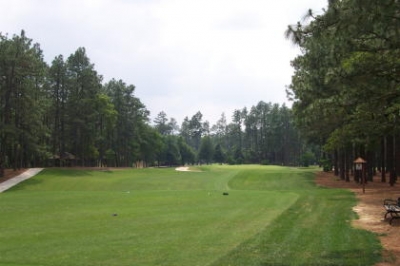 |
| You won't see a par three until the 6th hole -- and once you get there, you'll find another long iron challenge waiting for you. |
One of the most surprising things about the course is its playability. Genius is measured in different ways, but where else can you find a course where the average player can shoot close to his handicap score, yet the best professionals in the world struggle to stay within sight of par?
Jones says the brilliance is in the design. "What's so great about Course 2 is -- it doesn't intimidate you by the way it looks, but it'll take its toll unless you hit perfect shots. Plus, the recovery shots are different from other courses, because you're almost better off missing your shots on the near side to the pin, because the green's pitched uphill. You can either putt or chip it up the hill easily -- whereas on most courses you can't afford to miss on the near side, because the green slopes away from the hole."
"Payne Stewart made an unbelievable up and down on the 9th hole during the final round of the '99 Open -- he missed it on the long side of the green in the bunker, but was able to stop the ball from rolling off the edge of the putting surface with his sand shot. That's a perfect example of the type of precision you'll need if you miss on the far side, because you're starting to go downhill when you shoot towards the hole. That differs from a place liked Winged Foot, where the greens are not convex like Pinehurst -- they're concave, and if you miss on the near side, you've got no chance to recover," Jones added.
Thinking about it in hindsight, Jones is exactly right. By far the easiest up and downs were made from leaving it short of front pin positions, or from the side where the pin was located. And oddly enough, it's that lack of knowledge that helps people: "It's probably easiest to play Course 2 the first time you try it, because you don't know how much trouble you'll be in if you hit it long, or hit the wrong part of the green," Jones mused.
Ignorance can be bliss, after all.
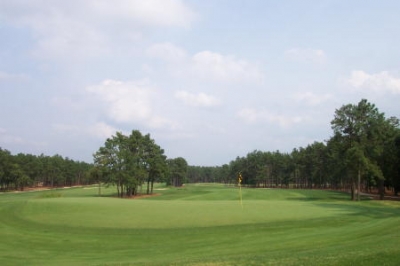 |
| The short par four 13th hole is hardly devoid of challenge. It's an uphill shot from the fairway, and missing the green doesn't leave attractive options. |
But there's no shortage of happiness when playing it. With your memories of the championships that were played there, you'll literally walk in the footsteps of the legends. Massei says players often do one better than that: "It's fun to watch people play the 18th green, where Stewart sank the putt, then made that dramatic gesture. We've now got the statue over to the side that captures that 'one moment in time,' so players are able to mimic the triumphant moment for themselves."
"Regardless of where the pin is on that particular day, or if it's a two foot putt or a thirty foot putt, you'll see people do a little fist pump, which is great," Massei said.
For Sunday patrons, it's perhaps a bit easier to replicate Stewart's motions, since the greens keeper positions the hole in the same location it was on that fateful day in June, 1999. All that's missing from the moment is the grandstand, filled with thousands of people -- and the intense pressure of needing to make a lengthy par putt to win a major title.
There's no such thing as highlight holes on Course 2, since each has its own charm and challenge. Particular favorites were holes two and five, two long and difficult par fours, hole seven, a terrific 'short' par four, eight, a par five for 'mortal' players, with a dramatically sloped green and a chance for birdie for people who play it smart.
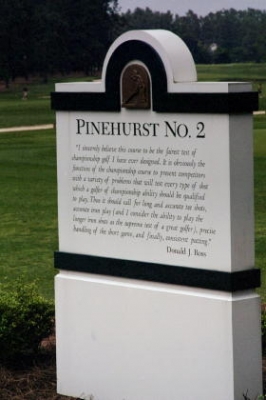 |
| Near the first tee, there's a note from Donald Ross. He says you'll be tested, but until you've played the course, you have little idea how much. |
Ten is a great, long, three-shot par five. Then there're four of the best par fours you'll ever play, in sequence. Sixteen has always been a favorite, both as a par five for resort players, or a par four for the pros. And who could argue with eighteen, with the clubhouse as the backdrop, Stewart's and Ross's statues looking on, and the weight of history on your shoulders?
To the person who would consider skipping Pinehurst 2 (there certainly aren't many) because the course doesn't 'wow' you in the aesthetic sense, there's only one thing to say -- don't. Because no matter what your expectations were for the course heading into the round, once you're picking up your ball from the cup on the 18th green -- they'll be exceeded. Guaranteed.
Note: Click on the highlighted link for an overview of the Pinehurst Resort, which includes links to write-ups of the other courses.
Click the links below for other stories on Pinehurst Resort.
Details:
Pinehurst Number 2
1 Carolina Vista
Village of Pinehurst, NC 28374
Reservations: (800) 487-4653
Website: www.pinehurst.com
Course Designer: Donald Ross, with Rees Jones handling the restoration.
Director of Golf: Matt Massei
Vice President of Golf Operations: Brad Kocher
Course Superintendent: Paul Jett
Pinehurst Resort is owned and operated by ClubCorp.
|
Tees |
Yardage/Slope |
Rating |
|
Gold |
7189/135 |
75.3 |
|
Blue |
6741/131 |
72.8 |
|
White |
6309/127/137 (L) |
70.8/77.4 (L) |
|
Green |
5836/120/130 (L) |
68.5/74.6 (L) |
|
Red |
5035/113/124 (L) |
64.9/69.6 (L) |
Rates:
Year-Round Stay and Play rack rates range from $266 - $725 per person, per night, based on two-night minimum, and includes dinner, breakfast, room and golf (plus tax and service charge). Surcharges may apply on championship courses and second rounds.
Call for Seasonal specials that run throughout the year, such as the $299 Summer Champions Special, including one day of unlimited golf or the popular Summer Tee, which gives an extra night's stay and additional round of golf when you book a two night golf package. Other packages include overnight golf and spa reduced-rate offers. See pinehurst.com/reservations for more details.
A particularly popular choice is the Donald Ross package in winter, which includes three rounds on Courses 1,3,5 or 6, for $266.
The $725 Ultimate golf package in high spring season includes unlimited golf on all courses, including one round on Course #2.
We strongly recommend that you consult the website and/or call the above number for package prices and availability, since you'll receive significant discounts over individual daily rates.
| Related Links | Comments on this article? | |
|
Maryland National Golf Club Hollow Creek Golf Club Rocky Gap Resort PB Dye Golf Club in Ijamsville Whiskey Creek Golf Club |
E-mail Jeff Rendall, Editor: jrendall@golftheunitedstates.com |











